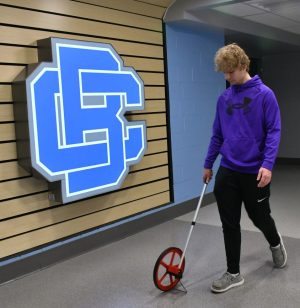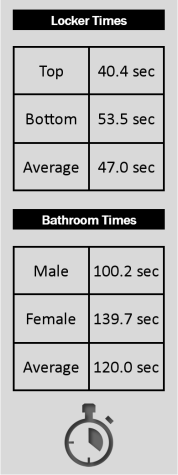Is 5 minutes between classes enough time?
Students calculate school travel times for physics research
March 14, 2023

(Oliver Myers)
Sophomore Phoenix Peck is not alone in this race against time.
Stepping out of his first block last semester, Peck had five minutes to cross the building from room No. 14 within the courtyard to the mobile units.
As construction continues and the school building is expanded, the distance students have to travel during the five minute class change has increased.
Hallway renovation further adds to this length as sections of the school are blocked off and students must take detours to reach their destination.
Randy Wilson’s Physics Honors class took it upon themselves to find the exact distance from the gym to the farthest mobile and calculated the required speed to make it from one end to the other within five minutes.
To determine the absolute worst case scenario, a meter wheel was used to measure the distance from the southeast corner of the gym to the door of the farthest mobile.
Taking this a step further, the students timed how long it took for them to walk the distance at a comfortable pace and collected the average time it took for students to stop at bathrooms and lockers.
The distance ended up being 405.9 meters or almost a quarter of a mile. This means that the average pace needed to be on time would be about 1.4 meters per second or 1.5 yards a second if the distance between one’s classes was the full distance of the school.
As it turned out, the average walking pace for an adult was exactly this. However, it must be taken into account that the distance is not in a straight line, nor do students have the same stride.
The path from the gym to the farthest mobile is littered with changes in direction and elevation which affect one’s pace.
In a field test conducted by the Wilson’s students, it took an average of 5.2 minutes to walk the full distance when the hallways were empty.
When applying traffic to the scenario and running a test during actual class changes, the overall average increased to 5.7 minutes.
On a side note, it was found that traveling from the mobile units to the gym was slower than traveling from the gym to the mobile units.
“[The difference] was the bottleneck going back into the building,” said Elhadj Cissé, a senior in the class.
“I was really surprised by the data,” said Connor Burns, a junior in the class. “I figured it would take much longer than it actually did, but it still took quite a bit of time.”
Traffic or not, the students would be late to class if these results were to be applied to reality. It should be considered that the administration gives a period of grace for those heading out to the mobiles or down to the gym so that students who must travel long distances are not given a late slip everyday.
Those heading to the mobiles simply have to reach outside, and those heading to the gym similarly have to reach the slope heading towards the upper part of the gym before the bell rings.

This still leaves the issue, however, of there being no spare time for a locker or bathroom break for these students.
“[A solution] may be for the kids [farther from their next class] to get out two minutes earlier so they have more time to get there,” said Alexis Kollar, a senior in the class.
Another solution suggested by junior Fanty Abibu who is also a part of the class was for students “not stopping and talking to friends.”
The average time students spent at their locker was found to be 47 seconds, with students assigned bottom lock
ers typically taking slightly longer than their upper companions.
“I’m not surprised that the bottom lockers had a higher time,” said Austin Balliett, a senior in the class, “because it takes more time to get down there, open it up, and then back up along with the traffic near you. It makes it a lot more claustrophobic.”
Lastly, bathroom breaks averaged about two minutes.
“I don’t think there is enough time between classes because it doesn’t give you enough time to go to lockers and use the restroom,” Kollar said.
In close, the students of Wilson’s Physics Honors class agree that the size of school pushes the limits of the 5 minute transition time. Although hallway management has taken this into consideration when handing out late slips for those heading to the mobiles and the gym, it leaves no time for any sort of locker visit or restroom break.
What motivated Wilson to have his students investigate this question? Was it to increase the passing time? Was it purely academic?
Neither, according to Wilson.
“It was just curiosity,” he said.